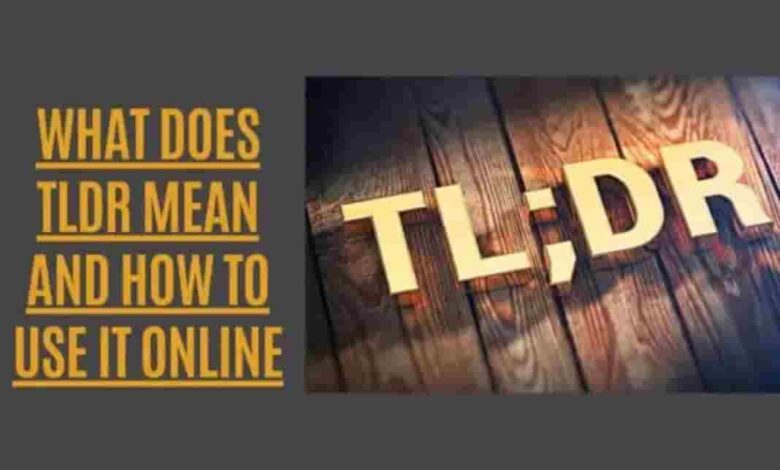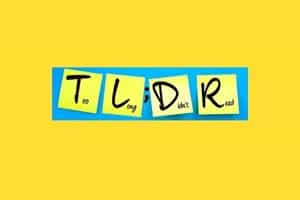What Does TLDR Mean And How to Use it Online

TL;DR is a very concise way of stating a message or thought. It stands for “too long; didn’t read.” Tldr is often used in email and social media posts, but it can also be found on Web pages and other documents. To use TLDR effectively, first, understand the abbreviation’s origins.
TLDR stands for “Too Long, Didn’t Read.” Too lengthy; didn’t read is abbreviated as TLDR.” It is used online to summarize or condense long articles into a more digestible format. TLDR can also convey that you do not have the time or inclination to read the entire article. Sometimes, TLDR may be used sarcastically to indicate that the author is not interested in discussing the article’s content.
TLDR (or TL;DR) has made it into news stories, business emails, and even Merriam-Webster. And where did the term TLDR come from, and what does it mean?
Too Long; Didn’t Read
There is an online abbreviation for “Too long; I didn’t read” known as TLDR (or TL;DR). The sentence’s meaning is clear at first look. TLDR is no exception to the rule that words and phrases can take on new meanings when used in a different context.
TLDR is an Internet slang term meaning “too long to read” when referring to digital content (such as an article, email, etc.). A single “TLDR?” followed by no more explanation might be meant to be amusing or insulting. It’s usually simply a wry acknowledgment that reading and processing a smaller portion of material is simpler than a massive wall of text.
However, you’ll rarely see a “TLDR” in a blog comment section (or anywhere). TLDRs often provide a brief description of what they read. Like “TLDR: the Patriots will win the next Super Bowl,” discovered after a long sports article.
To the same effect, writers may also include a TLDR at the beginning or end of their online forums, lengthy article, email, or text messages. This is designed to be a brief explanation of what the author is saying, and it serves as a caution that the details of a lengthy work may not be worth the effort of every reader. ‘”TLDR: this laptop sucks” may be the first line of a ten-paragraph product review. Here’s a fast rundown; continue reading if you want more information.
How to Utilize TLDR

It is only appropriate to utilize too long; didn’t read when summarizing a text, regardless of whether you are the author or an academic reviewer. Without a good summary of what you’ve just read, the word “TLDR” might be disrespectful (but, of course, that may be your intention).
Your work as a commenter is much easier when you use TLDR. To avoid coming out as nasty or juvenile, provide a helpful summary that other readers can comprehend.
Your job becomes more challenging while working with TLDR as an author. At the beginning of an article, a too long; didn’t read summary might save the reader’s time or act as an introduction, but it can also cause the reader to skip the intricacies of your work.
An end-of-article too long; didn’t read the summary might be useful since it recaps what the reader has previously taken in. However, in some cases, it might come off as mocking. Is the author acknowledging that a single line is all needed to make sense of their massive tome of text?
It’s all about context, whether professional or academic use. Never use too long; didn’t read in a context where you wouldn’t utter LOL, as a general rule. Although it is popular among programmers, marketers, and writers, you should consider stating “TL;DR” instead if you want to use TLDR professionally. Merriam-Webster Dictionary recognizes it as a word, and it’s more visually appealing than TLDR.
TLDR is a handy internet acronym for condensing a lot of information into a short amount of time. Try to avoid sounding nasty when you use it.
How Do you Utilize TLDR in the Workplace?
When utilizing too long; didn’t read in professional contexts, it is essential to keep in mind your audience’s level of familiarity with online slang. As a general guideline, avoid using too long; didn’t read in places where “LOL” (laughing out loud) or any equally simple abbreviation would be more appropriate.
Responding to professional emails with “TLDR” is generally not an option. This may easily be seen as snarky, unpleasant, and unprofessional, all of which are negative traits.
You may want to utilize TLDR in your message to suggest a briefing or conclusion. If you have long-form content or email, you may start it with the title “TLDR” and then use a bulleted list to summarize your major points.
The Benefits Of Using TLDR
TLDR stands for “Too Long Didn’t Read.” It is a term used to describe a situation where someone has read a text but found that it was too long and did not bother to finish it. Too long; didn’t read is also used to summarize long texts or news articles.
There are many benefits to using TLDR. First and foremost, it can help you save time. If you can quickly summarize a long text or online article, you can get the information you need without reading everything. Additionally, too long; didn’t read can help you retain information better. When you only have to read a text summary, you are more likely to remember the key points than if you had read the entire thing. Finally, too long; didn’t read can be helpful when trying to make a decision.
What Are Some Common Misconceptions About TLDR?
Many people think that “tl;dr” means “too long, didn’t read.” The acronym stands for “too long; didn’t read.” It’s used to indicate when a post or comment is so long that readers can’t be bothered to read it. There are a lot of misconceptions about what “tl;dr” means. Some people think it means “text me,” others believe it stands for “thank you.” And still, others feel that it means “too little, don’t respond.” The truth is that “tl;dr” is just a way to let people know that a post is too long, and they might not want to read it. It’s nothing more than that.
Conclusion
TLDR means “Too Long, Didn’t Read.” It indicates they can stop reading because the main points have been covered. It can be used in both written and oral communication. There are a few ways to use too long; I didn’t read effectively. One way is to use it as a call to action, telling the reader to stop reading and take action on what has been said.

